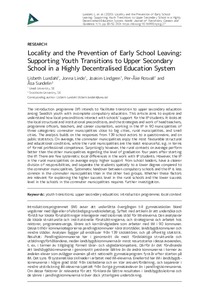Locality and the Prevention of Early School Leaving: Supporting Youth Transitions to Upper Secondary School in a Highly Decentralised Education System
Per-Åke Rosvall; Jonna Linde; Lisbeth Lundahl; Åsa Sundelin; Joakim Lindgren
https://urn.fi/URN:NBN:fi-fe2021042826524
Tiivistelmä
The introduction programme (IP) intends to facilitate transition to upper secondary education among Swedish youth with incomplete compulsory education. This article aims to explore and understand how local preconditions interact with schools’ support for the IP students. It looks at the local structural and institutional preconditions, and the strategies and work of head teachers, programme officers, teachers, and career counsellors, working in the IP in 90 municipalities of three categories: commuter municipalities close to big cities, rural municipalities, and small cities. The analysis builds on the responses from 139 school actors to a questionnaire, and on public statistics. On average, the commuter municipalities enjoy the most favourable structural and educational conditions, while the rural municipalities are the least resourceful, e.g. in terms of formal professional competence. Surprisingly however, the rural contexts on average perform better than the other municipalities regarding the level of graduation four years after starting the IP. There are few systematic local differences in the work with IP students. However, the IP in the rural municipalities on average enjoy higher support from school leaders, have a clearer division of responsibilities, and separate the students spatially to a lower degree compared to the commuter municipalities. Systematic handover between compulsory schools and the IP is less common in the commuter municipalities than in the other two groups. Whether these factors are relevant for explaining the higher success level in the rural schools and the lower success level in the schools in the commuter municipalities requires further investigation.
Kokoelmat
- Rinnakkaistallenteet [19207]
